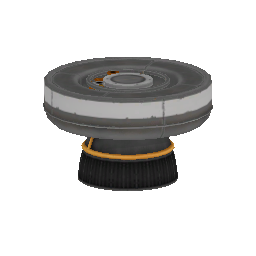Difference between revisions of "LV-909 "Terrier" Liquid Fuel Engine"
m |
(→Usage) |
||
| Line 9: | Line 9: | ||
The thrust vectoring on this engine tends to be less useful than on the LV-T45, due to the LV-909's reduced gimbal range and the fact that it is often used on lighter rockets, which can be turned easily by the [[SAS]] torque provided by the command pod or probe body. | The thrust vectoring on this engine tends to be less useful than on the LV-T45, due to the LV-909's reduced gimbal range and the fact that it is often used on lighter rockets, which can be turned easily by the [[SAS]] torque provided by the command pod or probe body. | ||
| + | |||
| + | Be aware that unlike the LV-T30 and -45, the LV-909 does not produce electric charge. | ||
== Description == | == Description == | ||
Revision as of 11:24, 24 December 2013
| LV-909 "Terrier" Liquid Fuel Engine | ||
| Liquid fuel engine by Jebediah Kerman's Junkyard and Spacecraft Parts Co | ||
| Radial size | Small | |
| Cost | (total) | 390.00 |
| Mass | (total) | 0.500 t |
| Drag | 0.2 | |
| Max. Temp. | 2000 K | |
| Impact Tolerance | 7 m/s | |
| Research | | |
| Unlock cost | 1 600 | |
| Since version | 0.14 | |
| Part configuration | liquidEngineLV-909_v2.cfg | |
| Maximum thrust | (1 atm) | 14.78 kN |
| (vacuum) | 60.00 kN | |
| Isp | (1 atm) | 85 s |
| (vacuum) | 345 s | |
| Fuel consumption | 3.55 | |
| Thrust vectoring | 4 ° | |
| Testing Environments | ||
| On the surface | Yes | |
| In the ocean | Yes | |
| On the launchpad | Yes | |
| In the atmosphere | Yes | |
| Sub-orbital | Yes | |
| In an orbit | Yes | |
| On an escape | Yes | |
| Docked | No | |
| Test by staging | Yes | |
| Manually testable | Yes | |
| Packed volume | 1300 l | |
The LV-909 Liquid Fuel Engine is a liquid fuel engine.
Usage
The LV-909 is a liquid fuel engine with thrust vector control, allowing efficient control of the rocket when it is most needed: during ascent, descent, and orbit correction burns. It has a slightly better specific impulse in vacuum than LV-T30 and LV-T45 engines and is much smaller and lighter than them, but it has dramatically less thrust. The low thrust makes the LV-909 unsuitable as a main engine on most lower stages, but the low mass allows for more efficient upper stages. Furthermore, the LV-909 is short enough that LT-1 Landing Struts can extend past it. Because of this, the LV-909 is a good choice for lander engines.
Like LV-T30 and -45, the LV-909 cannot be placed on radial decouplers. The LV-909 must be directly below a non-empty liquid fuel tank, or fed by an fuel line, to produce any thrust.
The thrust vectoring on this engine tends to be less useful than on the LV-T45, due to the LV-909's reduced gimbal range and the fact that it is often used on lighter rockets, which can be turned easily by the SAS torque provided by the command pod or probe body.
Be aware that unlike the LV-T30 and -45, the LV-909 does not produce electric charge.
Description
The LV-909 is one of the few parts in Kerbal Space Program that is covered in multi-layer insulation.
| “ | The 909 model was initially received with some skepticism by spacecraft engineers, as it defied the long-standing convention that "More Power!" is always better. Despite this, the 909 series has found its place in the spacecraft construction world, being particularly useful as a final stage and landing engine. — Jebediah Kerman's Junkyard and Spaceship Parts Co. |
” |
Created by: Mrbrownce
Changes
- New, higher quality model applied.
- Max thrust increased from 20 to 50; vacuum ISP reduced from 400 to 390.
- Initial Release

